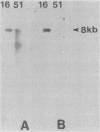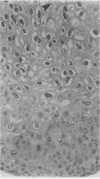Abstract
We cloned the DNA from a novel human papillomavirus (HPV) present in a cervical condyloma. When DNA from this isolate was hybridized at high stringency with HPV types 1 through 50 (HPV-1 through HPV-50), it showed weak homology with HPV-6 and -16 and stronger homology with HPV-26. A detailed restriction endonuclease map was prepared which showed marked differences from the maps for other HPVs that have been isolated from the female genital tract. Reassociation kinetic analysis revealed that HPV-26 and this new isolate were less than 10% homologous; hence, the new isolate is a novel strain of HPV. The approximate positions of the open reading frames of the new strain were surmised by hybridization with probes derived from individual open reading frames of HPV-16. In an analysis of 175 genital biopsies from patients with abnormal Papanicolaou smears, sequences hybridizing under highly stringent conditions to probes from this novel HPV type were found in 4.2, 6.1, and 2.4% of biopsies containing normal squamous epithelium, condylomata, and intraepithelial neoplasia, respectively. In addition, sequences homologous to probes from this novel isolate were detected in one of five cervical carcinomas examined.
Full text
PDF
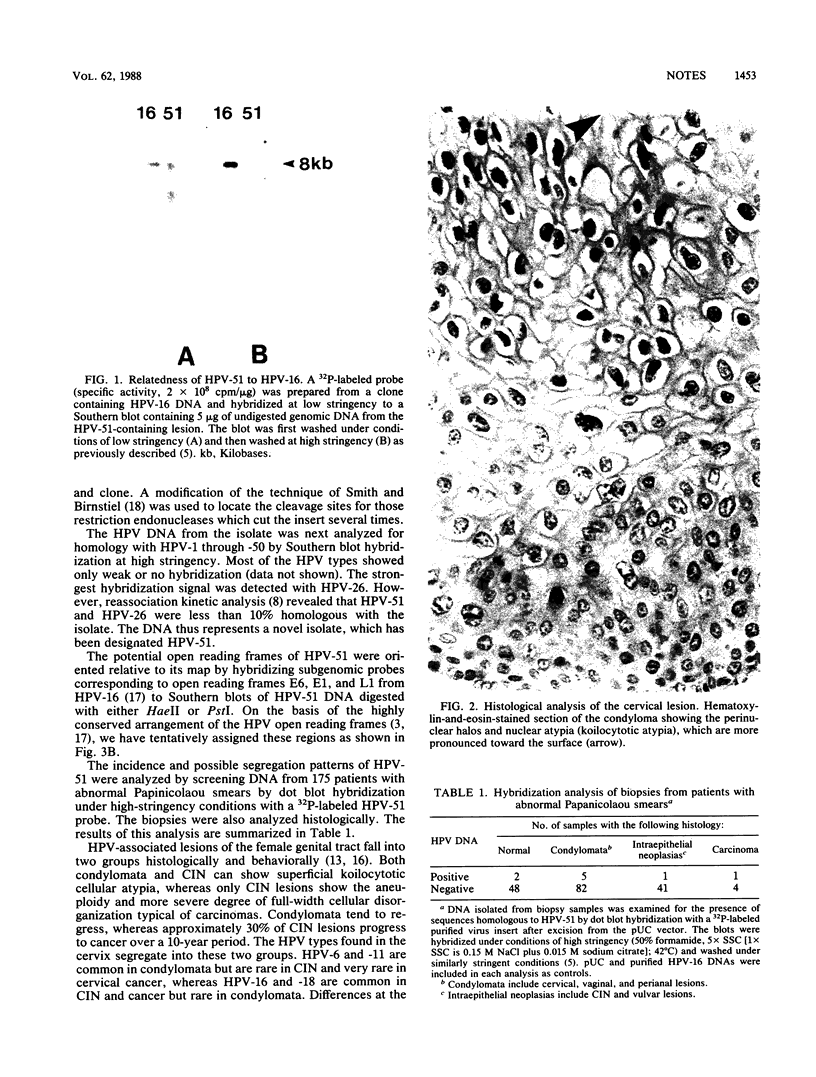
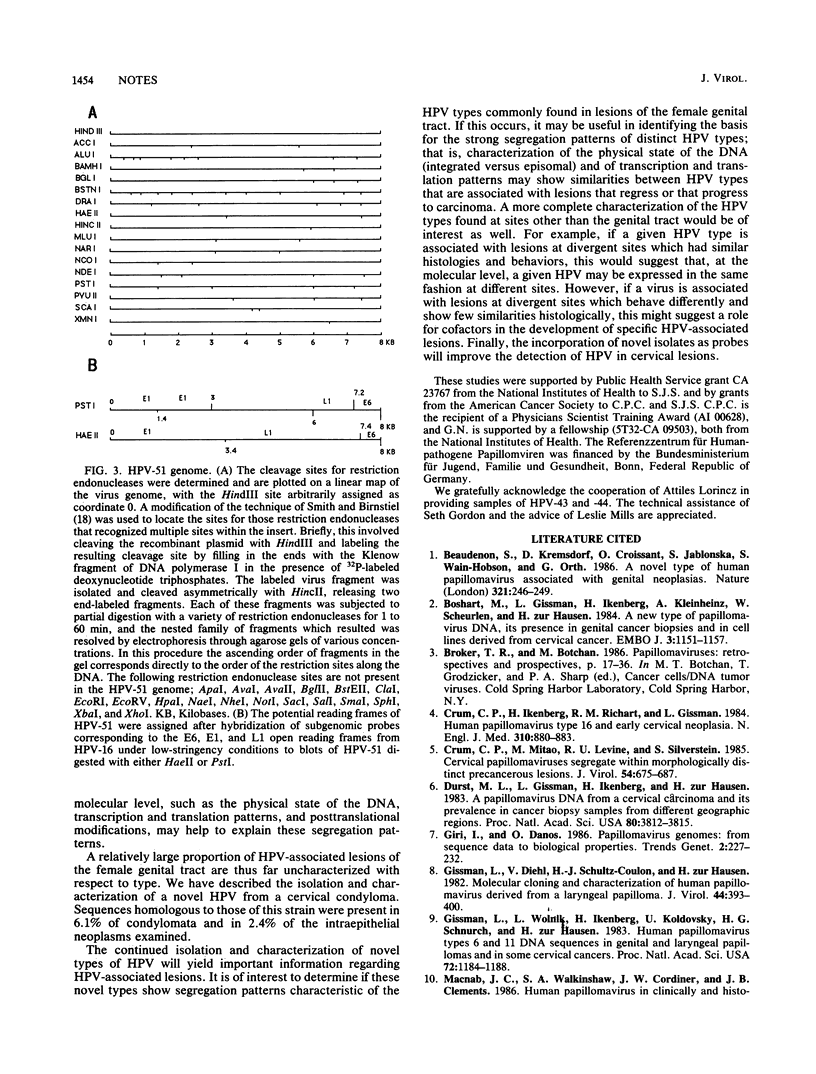
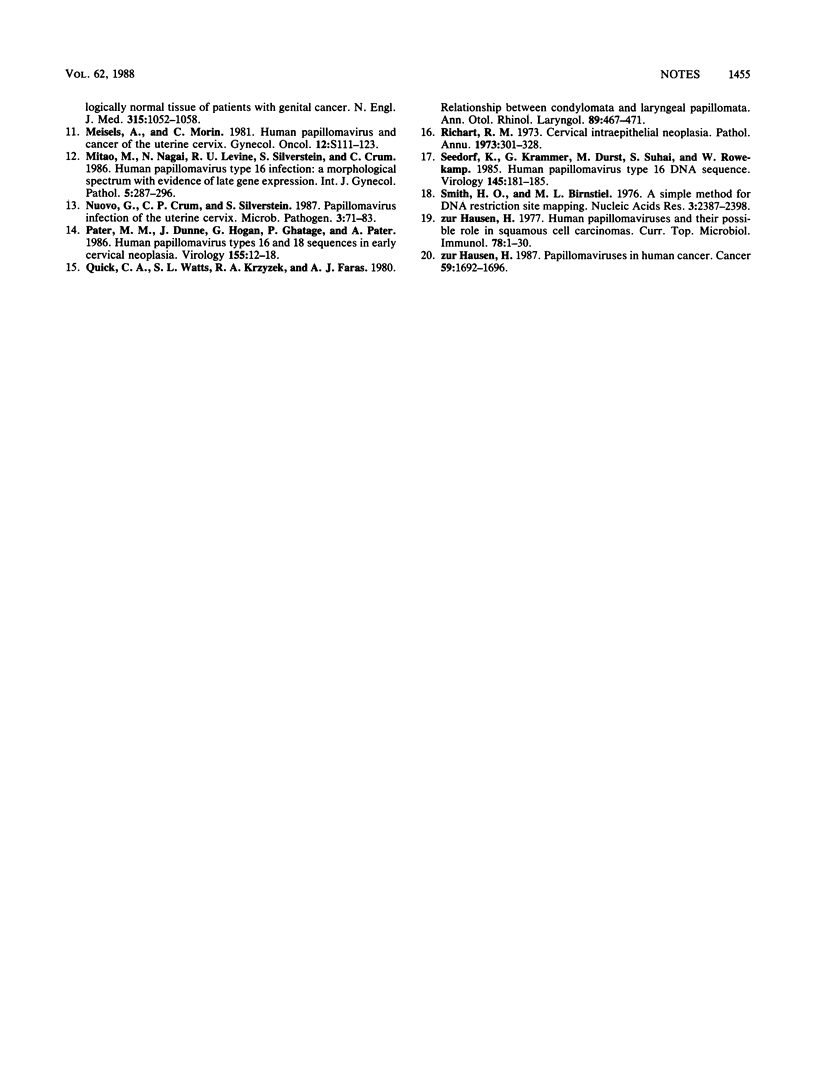
Images in this article
Selected References
These references are in PubMed. This may not be the complete list of references from this article.
- Beaudenon S., Kremsdorf D., Croissant O., Jablonska S., Wain-Hobson S., Orth G. A novel type of human papillomavirus associated with genital neoplasias. Nature. 1986 May 15;321(6067):246–249. doi: 10.1038/321246a0. [DOI] [PubMed] [Google Scholar]
- Boshart M., Gissmann L., Ikenberg H., Kleinheinz A., Scheurlen W., zur Hausen H. A new type of papillomavirus DNA, its presence in genital cancer biopsies and in cell lines derived from cervical cancer. EMBO J. 1984 May;3(5):1151–1157. doi: 10.1002/j.1460-2075.1984.tb01944.x. [DOI] [PMC free article] [PubMed] [Google Scholar]
- Crum C. P., Ikenberg H., Richart R. M., Gissman L. Human papillomavirus type 16 and early cervical neoplasia. N Engl J Med. 1984 Apr 5;310(14):880–883. doi: 10.1056/NEJM198404053101403. [DOI] [PubMed] [Google Scholar]
- Crum C. P., Mitao M., Levine R. U., Silverstein S. Cervical papillomaviruses segregate within morphologically distinct precancerous lesions. J Virol. 1985 Jun;54(3):675–681. doi: 10.1128/jvi.54.3.675-681.1985. [DOI] [PMC free article] [PubMed] [Google Scholar]
- Dürst M., Gissmann L., Ikenberg H., zur Hausen H. A papillomavirus DNA from a cervical carcinoma and its prevalence in cancer biopsy samples from different geographic regions. Proc Natl Acad Sci U S A. 1983 Jun;80(12):3812–3815. doi: 10.1073/pnas.80.12.3812. [DOI] [PMC free article] [PubMed] [Google Scholar]
- Gissmann L., Diehl V., Schultz-Coulon H. J., zur Hausen H. Molecular cloning and characterization of human papilloma virus DNA derived from a laryngeal papilloma. J Virol. 1982 Oct;44(1):393–400. doi: 10.1128/jvi.44.1.393-400.1982. [DOI] [PMC free article] [PubMed] [Google Scholar]
- Macnab J. C., Walkinshaw S. A., Cordiner J. W., Clements J. B. Human papillomavirus in clinically and histologically normal tissue of patients with genital cancer. N Engl J Med. 1986 Oct 23;315(17):1052–1058. doi: 10.1056/NEJM198610233151703. [DOI] [PubMed] [Google Scholar]
- Meisels A., Morin C. Human papillomavirus and cancer of the uterine cervix. Gynecol Oncol. 1981 Oct;12(2 Pt 2):S111–S123. doi: 10.1016/0090-8258(81)90066-4. [DOI] [PubMed] [Google Scholar]
- Mitao M., Nagai N., Levine R. U., Silverstein S. J., Crum C. P. Human papillomavirus type 16 infection: a morphological spectrum with evidence for late gene expression. Int J Gynecol Pathol. 1986;5(4):287–296. [PubMed] [Google Scholar]
- Nuovo G., Crum C. P., Silverstein S. Papillomavirus infection of the uterine cervix. Microb Pathog. 1987 Aug;3(2):71–78. doi: 10.1016/0882-4010(87)90065-9. [DOI] [PubMed] [Google Scholar]
- Pater M. M., Dunne J., Hogan G., Ghatage P., Pater A. Human papillomavirus types 16 and 18 sequences in early cervical neoplasia. Virology. 1986 Nov;155(1):13–18. doi: 10.1016/0042-6822(86)90163-7. [DOI] [PubMed] [Google Scholar]
- Quick C. A., Watts S. L., Krzyzek R. A., Faras A. J. Relationship between condylomata and laryngeal papillomata. Clinical and molecular virological evidence. Ann Otol Rhinol Laryngol. 1980 Sep-Oct;89(5 Pt 1):467–471. doi: 10.1177/000348948008900521. [DOI] [PubMed] [Google Scholar]
- Richart R. M. Cervical intraepithelial neoplasia. Pathol Annu. 1973;8:301–328. [PubMed] [Google Scholar]
- Seedorf K., Krämmer G., Dürst M., Suhai S., Röwekamp W. G. Human papillomavirus type 16 DNA sequence. Virology. 1985 Aug;145(1):181–185. doi: 10.1016/0042-6822(85)90214-4. [DOI] [PubMed] [Google Scholar]
- Smith H. O., Birnstiel M. L. A simple method for DNA restriction site mapping. Nucleic Acids Res. 1976 Sep;3(9):2387–2398. doi: 10.1093/nar/3.9.2387. [DOI] [PMC free article] [PubMed] [Google Scholar]
- zur Hausen H. Human papillomaviruses and their possible role in squamous cell carcinomas. Curr Top Microbiol Immunol. 1977;78:1–30. doi: 10.1007/978-3-642-66800-5_1. [DOI] [PubMed] [Google Scholar]
- zur Hausen H. Papillomaviruses in human cancer. Cancer. 1987 May 15;59(10):1692–1696. doi: 10.1002/1097-0142(19870515)59:10<1692::aid-cncr2820591003>3.0.co;2-f. [DOI] [PubMed] [Google Scholar]



